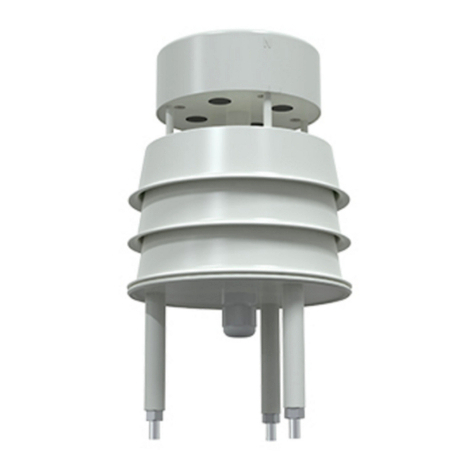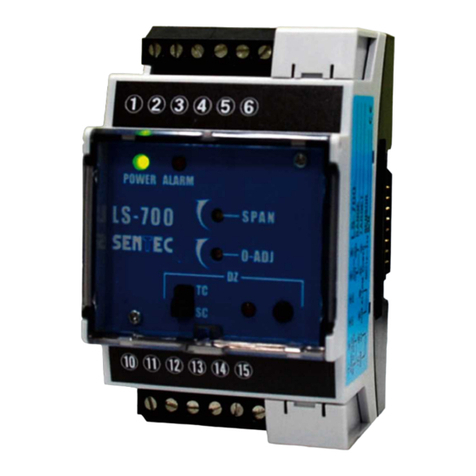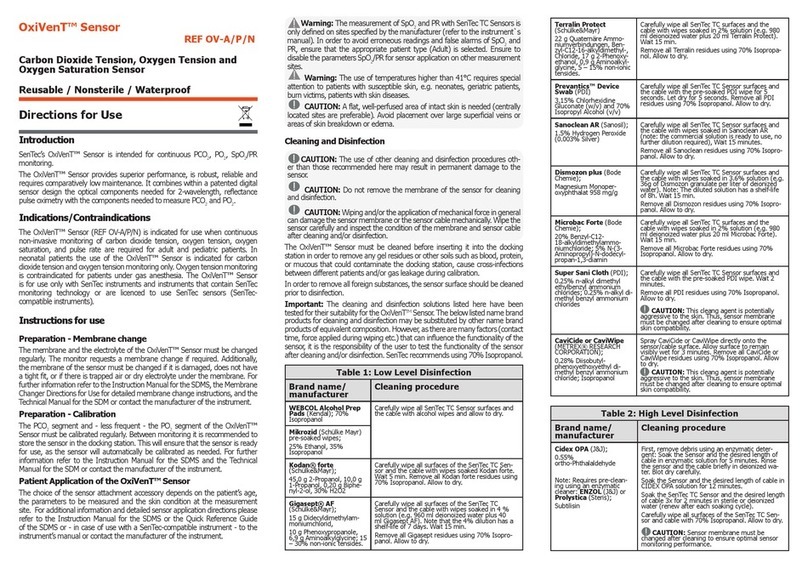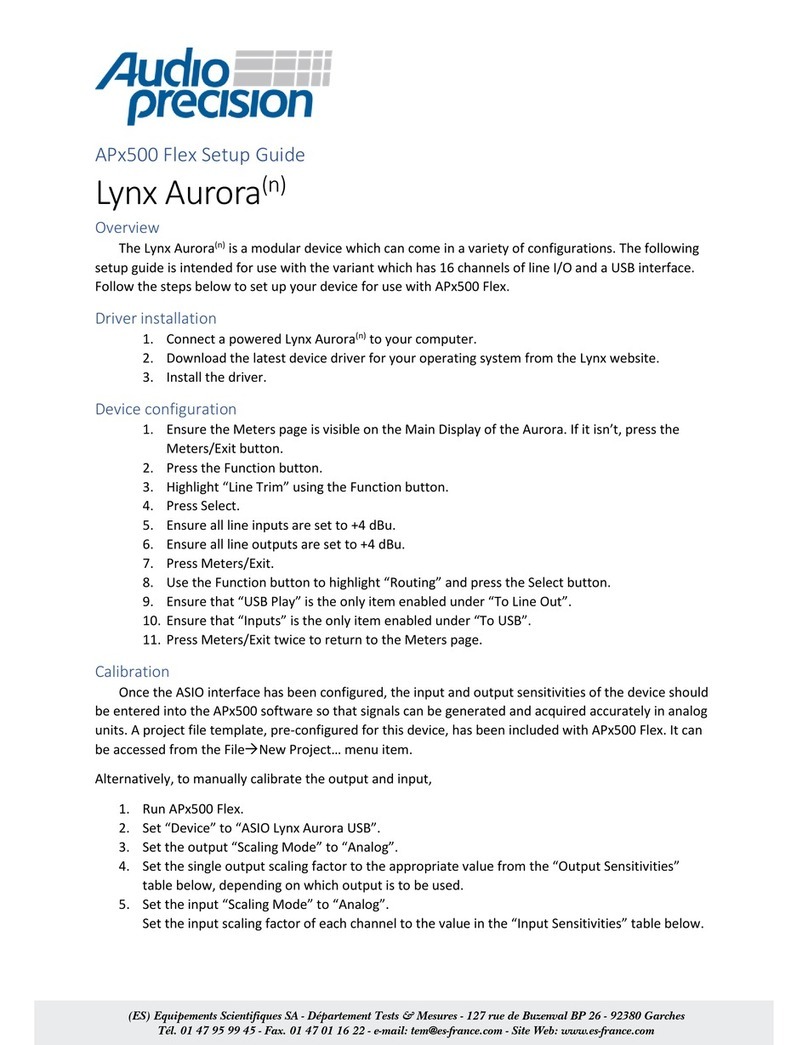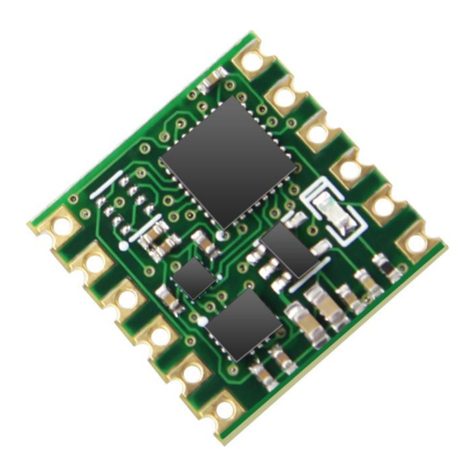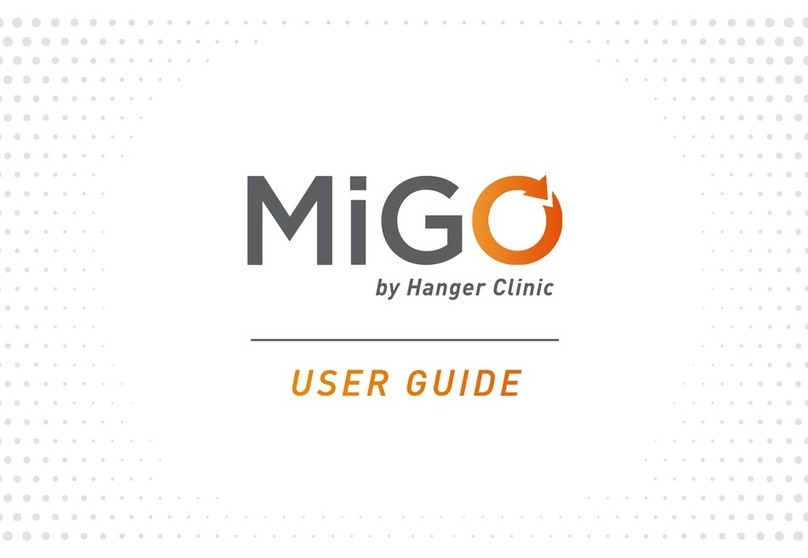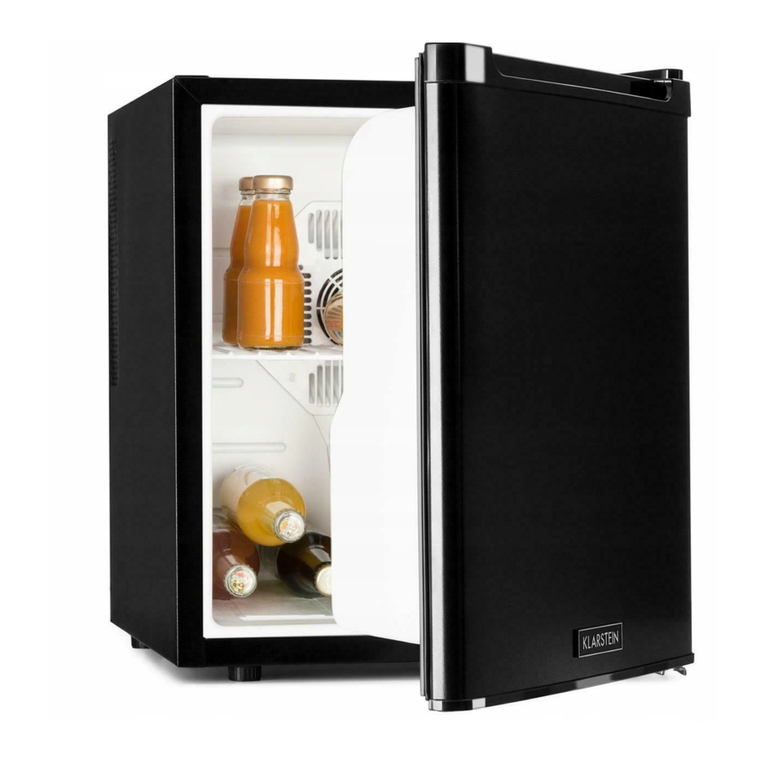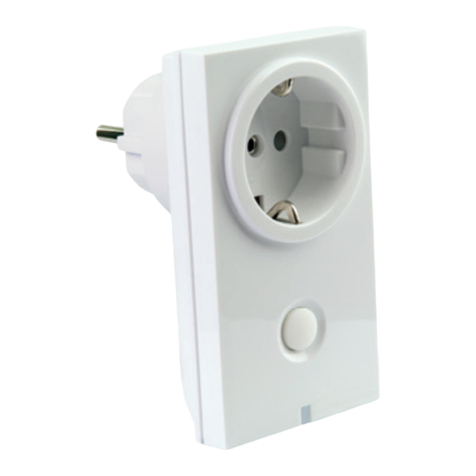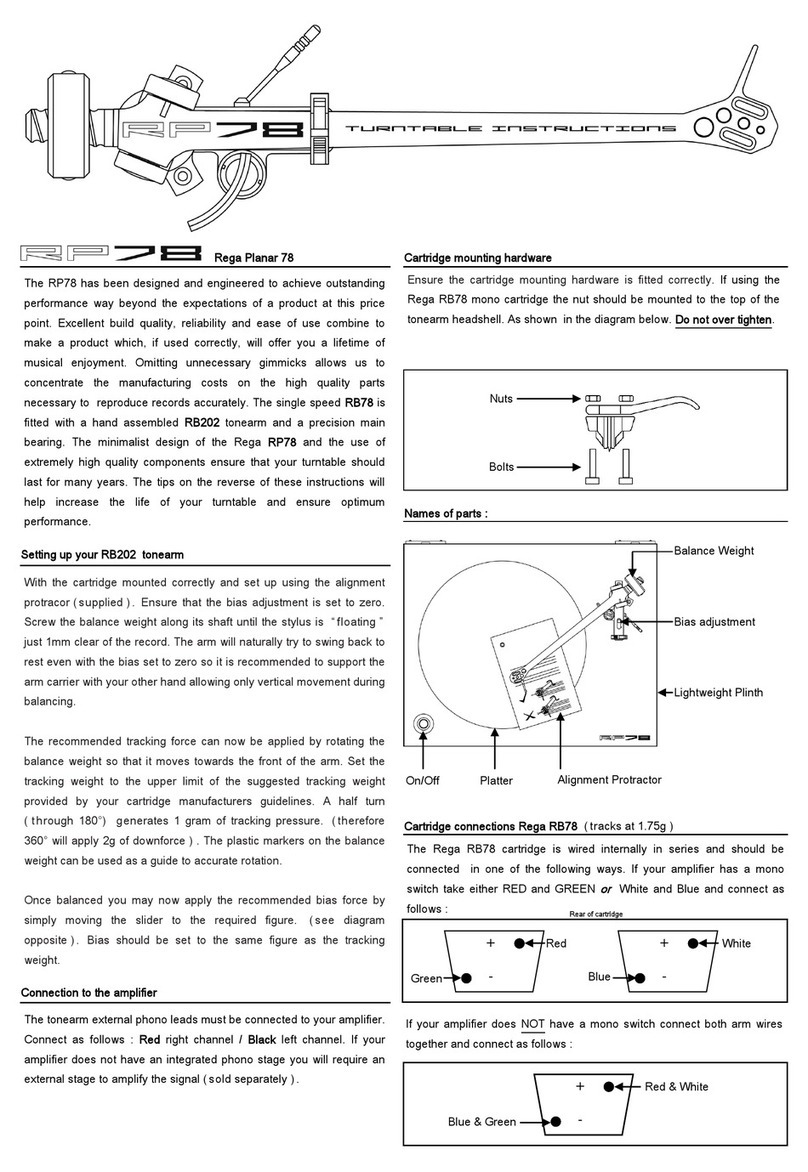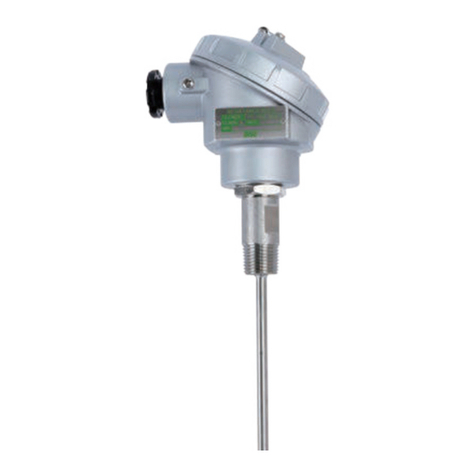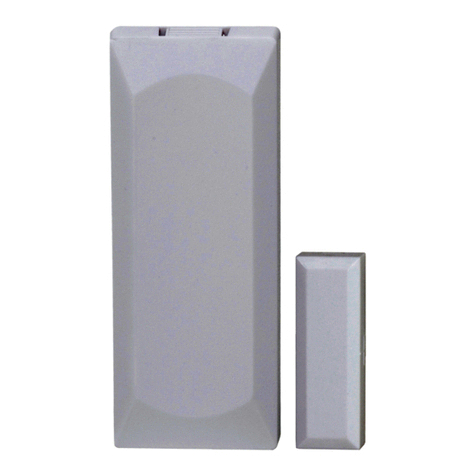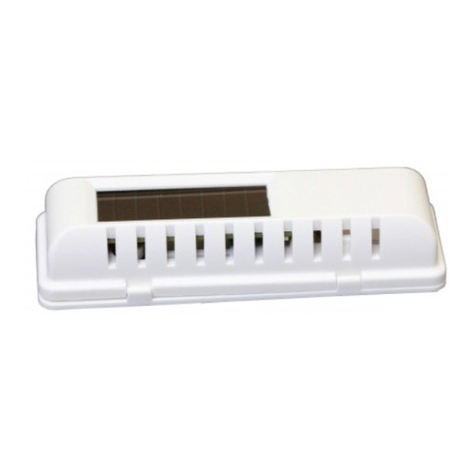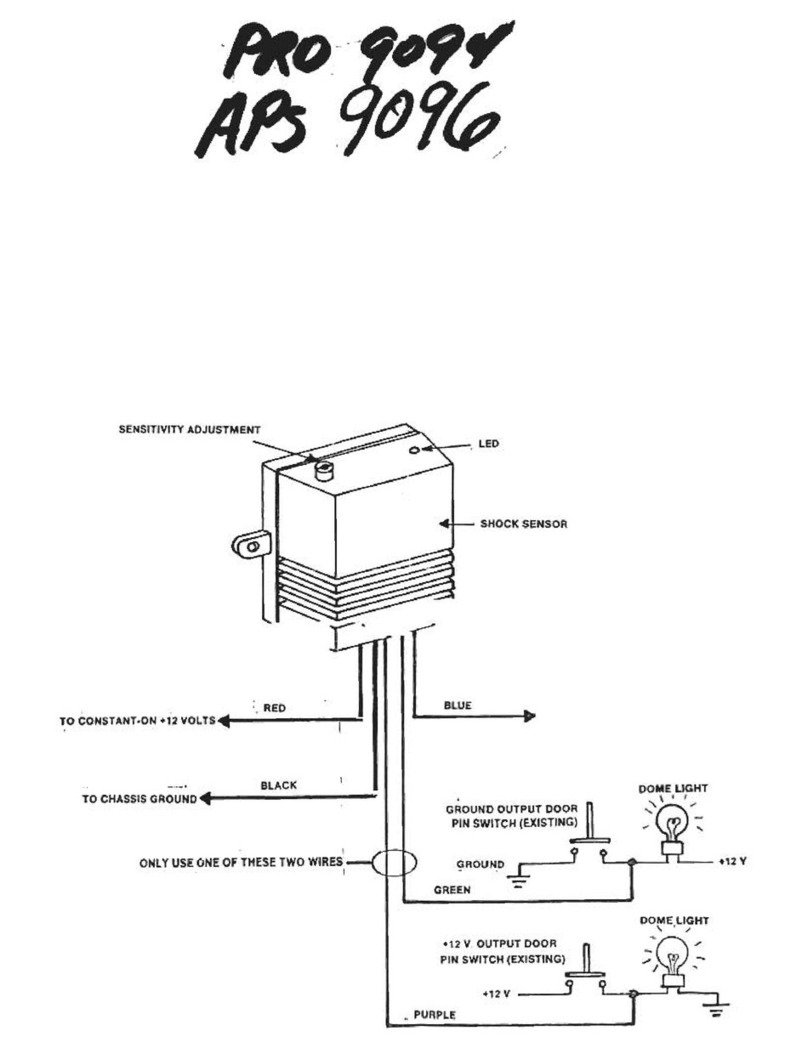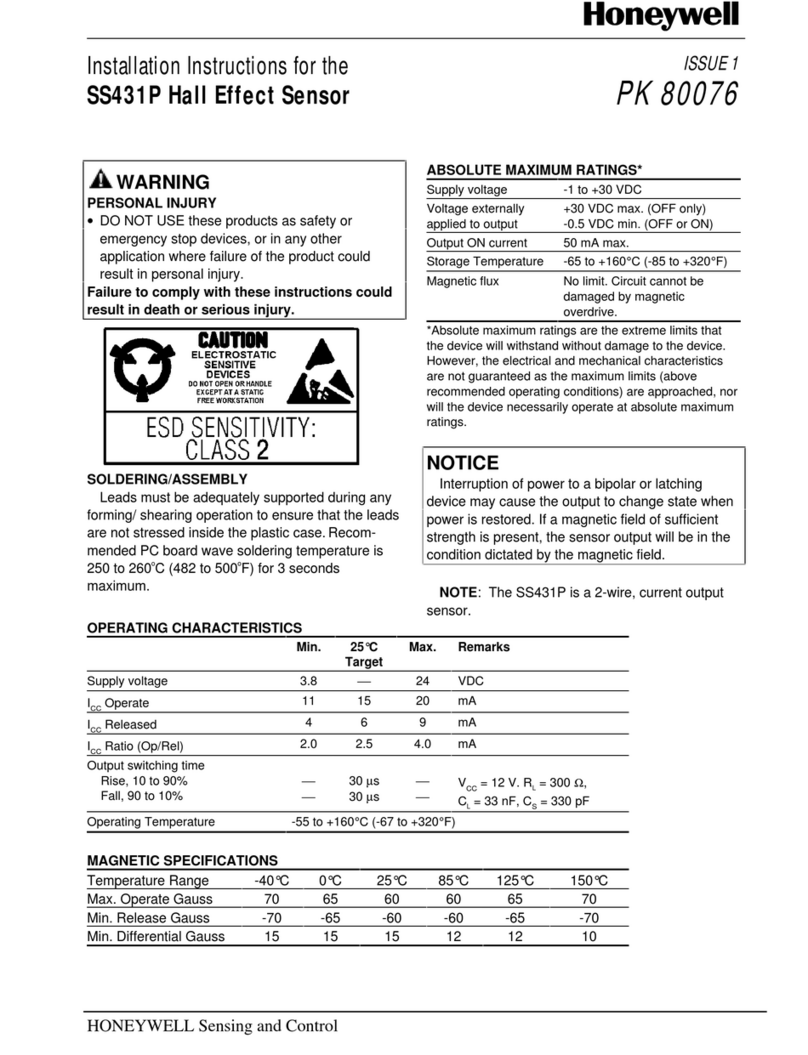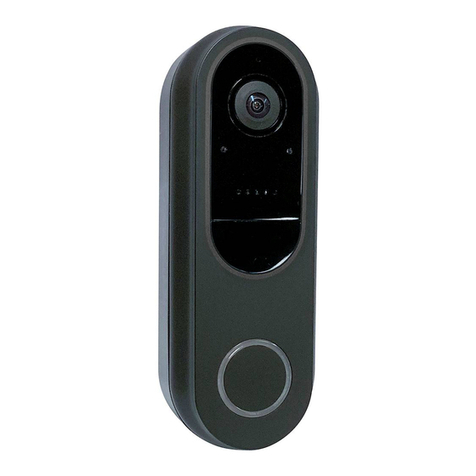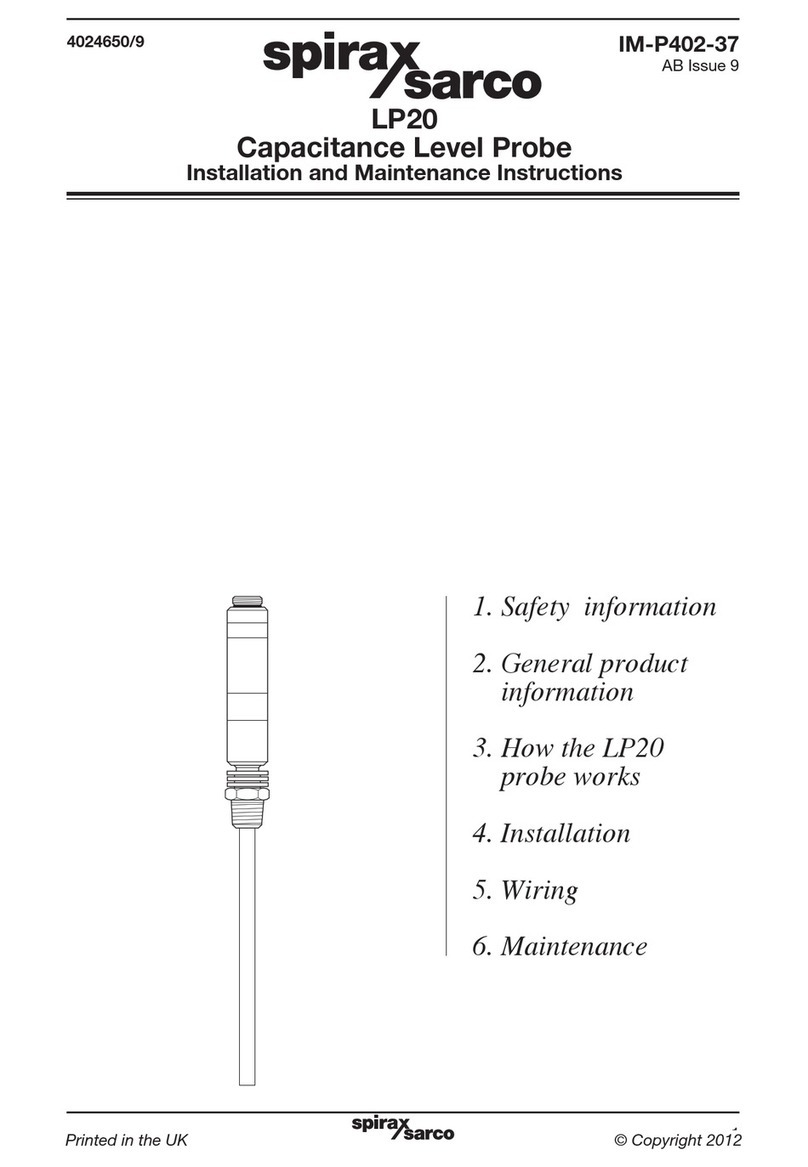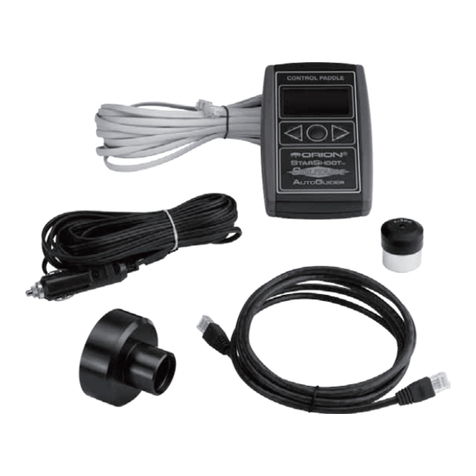Sentec V-Sign Sensor 2 Manual

Warning: The measurement of SpO2and PR with SenTec TC Sensors is
only defined on sites specified by the manufacturer (refer to the instrument`s
manual). In order to avoid erroneous readings and false alarms of SpO2and PR,
ensure that the appropriate patient type (Adult) is selected. Ensure to disable
the parameters SpO2/PR for sensor application on other measurement sites.
Warning: The use of temperatures higher than 41°C requires special
attention to patients with susceptible skin, e.g. neonates, geriatric patients, burn
victims, patients with skin diseases.
CAUTION: A flat, well-perfused area of intact skin is needed (centrally
located sites are preferable). Avoid placement over large superficial veins or
areas of skin breakdown or edema.
Cleaning and Disinfection
CAUTION: The use of other cleaning and disinfection procedures other
than those recommended here may result in permanent damage to the sensor.
CAUTION: Do not remove the membrane of the sensor for cleaning and
disinfection.
CAUTION: Wiping and/or the application of mechanical force in general
can damage the sensor membrane or the sensor cable mechanically. Wipe the
sensor carefully and inspect the condition of the membrane and sensor cable
after cleaning and/or disinfection.
The V-Sign™ Sensor 2 must be cleaned before inserting it into the docking
station in order to remove any gel residues or other soils such as blood, protein,
or mucous that could contaminate the docking station, cause cross-infections
between different patients and/or gas leakage during calibration.
In order to remove all foreign substances, the sensor should be cleaned prior
disinfection.
Important: The cleaning and disinfection solutions listed here have been tested
for their suitability for the V-SignTM Sensor. The below listed name brand products
for cleaning and disinfection may be substituted by other name brand products of
equivalent composition. However, as there are many factors (contact time, force
applied during wiping etc.) that can influence the functionality of the sensor, it is
the responsibility of the user to test the functionality of the sensor after cleaning
and/or disinfection. SenTec recommends using 70% Isopropanol.
Table 1: Low Level Disinfection
Brand name/
manufacturer Cleaning procedure
WEBCOL Alcohol Prep
Pads (Kendal)
; 70%
Isopropanol
Carefully wipe all SenTec TC Sensor surfaces
and the cable with alcohol wipes and allow to
dry.
Mikrozid (Schülke Mayr)
pre-soaked wipes;
25% Ethanol, 35%
Isopropanol
Kodan® forte
(Schülke&Mayr);
45,0 g 2-Propanol, 10,0 g
1-Propanol, 0,20 g Biphenyl-
2-ol, 30% H2O2
Carefully wipe all surfaces of the SenTec TC
Sensor and the cable with wipes soaked Kodan
forte. Wait 5 min. Remove all Kodan forte resi-
dues using 70% Isopropanol. Allow to dry.
Gigasept® AF
(Schülke&Mayr);
15 g Didecyldimethylammoni-
umchlorid,
10 g Phenoxypropanole, 6,9
g Aminoalkylglycine; 15 –
30% non-ionic tensides.
Carefully wipe all surfaces of the SenTec TC
Sensor and the cable with wipes soaked in 4%
solution (e.g. 960 ml deionoized water plus 40
ml Gigasept AF). Note that the 4% dilution has
a shelf-life of 7 days. Wait 15 min.
Remove all Gigasept residues using 70% Iso-
propanol. Allow to dry.
V-Sign™ Sensor 2
REF VS-A/P/N
Carbon Dioxide Tension and
Oxygen Saturation Sensor
Reusable / Nonsterile / Waterproof
Directions for Use
Introduction
SenTec’s V-Sign™ Sensor 2 is intended for continuous PCO2, SpO2/PR monitoring.
The V-Sign™ Sensor 2 provides superior performance, is robust, reliable and
requires comparatively low maintenance. It combines within a patented digital
sensor design the optical components needed for 2-wavelength, reflectance pulse
oximetry with the components needed to measure PCO2.
Indications/Contraindications
The V-Sign™ Sensor 2 (VS-A/P/N) is indicated for use when continuous non-
invasive monitoring of carbon dioxide tension, oxygen saturation, and pulse rate
are required for adult and pediatric patients. In neonatal patients the use of the
V-Sign™ Sensor 2 is indicated for carbon dioxide tension monitoring only. The
V-Sign™ Sensor 2 is for use only with SenTec instruments and instruments that
contain SenTec monitoring technology or are licenced to use SenTec sensors
(SenTec-compatible instruments).
Instructions for use
Preparation - Membrane change
The membrane and the electrolyte of the V-Sign™Sensor must be changed
regularly. The monitor requests a membrane change if required. Additionally, the
membrane of the sensor must be changed if it is damaged, does not have a tight
fit, or if there is trapped air or dry electrolyte under the membrane. For further
information refer to the Instruction Manual for the SenTec Digital Monitoring
System (SDMS), the Membrane Changer Directions for Use for detailed
membrane change instructions, and the Technical Manual for the SDM or contact
the manufacturer of the instrument.
Preparation - Calibration
The PCO2segment of the V-Sign™Sensor 2 must be calibrated regularly. The
monitor requests a sensor calibration if required. Between monitoring it is
recommended to store the sensor in the docking station. This will ensure that the
sensor is ready for use, as the sensor will automatically be calibrated as needed.
For further information refer to the Instruction Manual for the SDMS and the
Technical Manual for the SDM or contact the manufacturer of the instrument.
Patient Application of the V-Sign™ Sensor
The choice of the sensor attachment accessory depends on the patient’s age, the
parameters to be measured and the skin condition at the measurement site. For
additional information and detailed sensor application directions please refer to the
Instruction Manual for the SDMS or the Quick Reference Guide of the SDMS or - in
case of use with a SenTec-compatible instrument - to the instrument’s manual or
contact the manufacturer of the instrument.
Terralin Protect
(Schülke&Mayr)
22 g Quaternäre Ammonium-
verbindungen, Benzyl-C12-
16-alkyldimethyl-, Chloride,
17 g 2-Phenoxyethanol, 0,9 g
Aminoalkylglycine, 5 – 15%
non-ionic tensides.
Carefully wipe all SenTec TC surfaces and the
cable with wipes soaked in 2% solution (e.g.
980 ml deionoized water plus 20 ml Terralin Pro-
tect). Wait 15 min.
Remove all Terralin residues using 70% Isopro-
panol. Allow to dry.
Prevantics™ Device Swab
(PDI);
3.15% Chlorhexidine Gluco-
nate (w/v) and 70% Isopro-
pyl Alcohol (v/v)
Carefully wipe all SenTec TC Sensor surfaces
and the cable with the pre-soaked PDI wipe
for 5 seconds. Let dry for 5 seconds. Remove
all PDI residues using 70% Isopropanol. Allow
to dry.
Sanoclean AR (Sanosil);
1.5% Hydrogen Peroxide
(0.003% Silver)
Carefully wipe all SenTec TC Sensor surfaces
and the cable with wipes soaked in Sanoclean
AR (note: the commercial solution is ready
to use, no further dilution required), Wait 15
minutes.
Remove all Sanoclean residues using 70% Iso-
propanol. Allow to dry.
Dismozon plus (Bode
Chemie);
Magnesium Monoper-
oxyphthalat 958 mg/g
Carefully wipe all SenTec TC Sensor surfaces
and the cable with wipes soaked in 3.6% solu-
tion (e.g. 36g of Dismozon granulate per liter of
deionized water). Note: The diluted solution has
a shelf-life of 8h. Wait 15 min.
Remove all Dismozon residues using 70% Iso-
propanol. Allow to dry.
Microbac Forte (Bode
Chemie);
20% Benzyl-C12-18-alkyldi-
methylammoniumchloride;
5% N-(3-Aminopropyl)-N-
dodecylpropan-1,3-diamin
Carefully wipe all SenTec TC surfaces and the
cable with wipes soaked in 2% solution (e.g.
980 ml deionoized water plus 20 ml Microbac
Forte). Wait 15 min.
Remove all Microbac Forte residues using 70%
Isopropanol. Allow to dry.
Super Sani Cloth (PDI);
0.25% n-alkyl dimethyl ethyl-
benzyl ammonium chlorides
0.25% n-alkyl dimethyl ben-
zyl ammonium chlorides
Carefully wipe all SenTec TC Sensor surfaces
and the cable with the pre-soaked PDI wipe.
Wait 2 minutes.
Remove all PDI residues using 70% Isopropa-
nol. Allow to dry.
CAUTION: This cleang agent is potentially
aggressive to the skin. Thus, sensor membrane
must be changed after cleaning to ensure opti-
mal skin compatibility.
CaviCide or CaviWipe
(METREX® RESEARCH
CORPORATION)
0.28% Diisobutyl-phenoxye-
thoxyethyl dimethyl ben-
zyl ammonium chloride;
Isopropanol
Spray CaviCide or CaviWipe directly onto the
sensor/cable surface. Allow surface to remain
visibly wet for 3 minutes. Remove all CaviCide
or CaviWipe residues using 70% Isopropanol.
Allow to dry.
CAUTION: This cleang agent is potentially
aggressive to the skin. Thus, sensor membrane
must be changed after cleaning to ensure opti-
mal skin compatibility.
Table 2: High Level Disinfection
Brand name/
manufacturer Cleaning procedure
Cidex OPA (J&J) (*);
0.55% ortho-Phthalaldehyde
Note: Requires pre-cleaning
using an enzymatic cleaner:
ENZOL (J&J) or Prolystica
(Steris);
Subtilisin
First, remove debris using an enzymatic deter-
gent: Soak the Sensor and the desired length of
cable in enzymatic solution for 5 minutes. Rinse
the sensor and the cable briefly in deionized
water. Blot dry carefully.
Soak the Sensor and the desired length of cable
in CIDEX OPA solution for 12 minutes.
Soak the SenTec TC Sensor and the desired
length of cable 3x for 2 minutes in sterile or de-
ionized water (renew after each soaking cycle).
Carefully wipe all surfaces of the SenTec TC
Sensor and cable with 70% Isopropanol. Allow
to dry.
CAUTION: Sensor membrane must be
changed after cleaning to ensure optimal sensor
monitoring performance.

Sani Cloth Bleach (PDI);
Sodium Hypochloride 0.63%
Approx. 6000 ppm available
free chlorine
Carefully wipe all SenTec TC Sensor surfaces
and the cable with the pre-soaked PDI wipe.
Wait 4 minutes
Remove all PDI residues using 70% Isopropanol.
Allow to dry.
CAUTION: Do not use bleach cleaners on
sensor surfaces without or with defect mem-
brane. This may damage the PCO2unit.
CAUTION: Bleach is potentially aggressive
to the skin. Thus, sensor membrane must be
changed after cleaning to ensure optimal skin
compatibility.
Clorox Healthcare Bleach
Germicidal Wipes;
5500 ppm Sodium
Hypochloride
Mikrozid® PAA wipes
(Schülke & Mayr);
0.07% Per-Acetic acid; Hy-
drogen Peroxide, Acetic acid
Carefully wipe all SenTec TC Sensor surfaces
and the cable with the pre-soaked Mikrozid PAA
wipes, Wait 15 min. Remove all Mikrozid PAA
residues using 70% Isopropanol. Allow to dry.
Applying force, e.g. during wiping, can damage the sensor cable and sensor
membrane mechanically. After cleaning, verify that the membrane is not dam-
aged and that there are no air bubbles between membrane and sensor surface.
The membrane ring must be securely seated on the sensor. In case of damages,
trapped air or loose fit the membrane must be changed. Do not use the sensor if
there is any visible damage.
Important: Always calibrate the sensor after cleaning and/or disinfection.
Note: For further information please refer to the Instruction Manual for the SDMS
or contact the manufacturer of the instrument.
Compatibility of V-Sign™ Sensor 2 with dierent instru-
ments
Before starting a measurement, please check the sensor’s compatibility with the
connected instrument.
Conntection to SDM: The V-SignTM Sensor 2 requires firmware versions SMB
V07.00.4 and MPB V05.00.06 or newer. The SMB and MPB version of the monitor
may be found in the SDM menu “System Information”. Please contact your local
SenTec representative for firmware upgrade information.
Other SenTec-compatible instruments: Consult individual manufacturers
for compatibility of of particular instruments and sensor models. Each manufac-
turer of SenTec-compatible instruments is responsible for determining whether
and under what conditions its instruments are compatible for safe and effective
use with each SenTec sensor model. This may include different specifications and/
or warnings, cautions, or contraindications. Refer to the intrument’s manual or
consult manufacturer for complete instructions for use of this sensor with their
SenTec-compatible instrument.
Accuracy
For accuracy specifications of the V-Sign™ Sensor 2 when used with SenTec
monitors refer to the Technical Specifications in the Technical Manual of the
SenTec Digital Monitor. For accuracy specifications of the V-Sign™ Sensor 2 when
used with SenTec-compatible instruments refer to the instrument`s manual or
contact the instrument manufacturer.
Useful life
Under normal wear and tear the expected life time of the V-Sign™ Sensor is
typically 18 months.
WARNINGS
• Sensors are designed for use with specific monitors. The user and/or operator
must verify the compatibility of the monitor, sensor, and cables before use or
patient injury may result.
• Failure to handle/apply the V-Sign™ Sensor 2 properly may cause inaccurate
measurements.
• Keep the V-Sign™ Sensor 2 (as well as any discarded parts) out of reach of
children under the age of 5 years. The sensor is small enough to be swallowed
and may block the trachea.
• Ensure that the V-Sign™ Sensor 2 is physically intact, with no broken or
damaged parts. Discontinue use immediately if any defects are noted.
• Do not touch the V-Sign™ Sensor 2 membrane with any sharp-edged objects
or your fingernails. Damage of the sensor membrane will cause inaccurate
measurements.
• Do not alter or modify the V-Sign™ Sensor 2.
• To ensure accurate data verify that the sensing elements on the V-Sign™ Sensor
2 membrane-face are completely covered by the measurement site.
• Carefully route and fix sensor cables to reduce the possibility of patient
entanglement or strangulation.
• Do not use the V-Sign™ Sensor 2 during MRI scanning. Conducted current may
cause burns. Also, the V-Sign™ Sensor 2 may affect the MRI image, and the
MRI unit may affect the accuracy of oximetry measurements.
• The sensor can be kept on the patient during defibrillation, burns are possible
under very rare circumstances.
• Physically separate the sensor and cables from electro-surgical equipment
during electro-surgery. Do not place the sensor between cutting and counter
electrode.
• Any change in cutaneous PcCO2may be due to either a change in arterial PCO2,
or due to a change in skin blood flow under the V-Sign™ Sensor 2. Cutaneous
PcCO2only reflects arterial PCO2at relatively high local blood flow.
• Do not expose the V-Sign™ Sensor 2 to strong ambient light such as direct
sunlight, surgical lamps, infrared warming lamps, and phototherapy lights
during clinical use. This may cause inaccurate measurements. In such cases,
cover the sensor with an opaque material.
• Excessive motion may compromise the performance of the V-Sign™ Sensor 2.
• SpO2readings may be falsely low in the presence of tricuspid valve insufficiency
(mixture of arterial and venous values) due to retrograde venous pulsations.
• The pulsations from intra-aortic balloon support can be additive to the pulse
rate on the oximeter pulse rate display. Verify pulse rate against ECG heart rate.
• Intravascular dyes may lead to inaccurate SpO2measurements.
• Elevated levels of Methemoglobin (MetHb) and/or Carboxyhemoglobin (COHb)
will lead to inaccurate SpO2measurements.
• Furthermore, the following situations may result in reduced accuracy of the
V-Sign™ Sensor 2 readings: dysfunctional hemoglobins, anemia, intravascular
dyes, low perfusion at the measurement site, venous pulsations, certain
cardiovascular pathologies, skin pigmentation, externally applied coloring
agents, prolonged and/or excessive patient movement, exposure of the sensor
to high ambient light levels, defibrillation.
• Ensure to select the upper alarm limit for SpO2carefully and in accord with
accepted clinical standards. High oxygen levels may predispose a premature
infant to develop retinopathy.
• Always apply sensor on intact and closed skin sites. Pierced earlobes may
result in incorrect tcPCO2measurements. Do not apply to injured skin. Avoid
placement over large superficial veins.
• After observation of any skin irritations, do not apply the V-Sign™ Sensor 2
to the same measurement site. Unless the patient’s local skin perfusion and
physiological condition improved significantly do not apply the sensor to any
other measurement site.
• The recommended/ default application duration per measurement site (site
time) is 8 hours but longer site times are possible (up to 12 hours). Refer to the
Technical Manual for the SDM (when used with SenTec-compatible instruments
refer to the instrument`s manual) for further information. Exercise extreme
caution and assess the measurement site at least every 2 hours with poorly
SenTec AG, Ringstrasse 39, CH-4106 Therwil, Switzerland
www.sentec.com HB-005148-l
Date of release: 03/2019
perfused patients.
• Regularly inspect the sensor. Do not use the sensor if there is any visible damage
to the sensor housing, sensor membrane, sensor cable or if the color of the ring
around the glass electrode has a metallic luster. Change the sensor membrane if
it is damaged or missing, has a loose fit, or if there is trapped air or dry electrolyte
under the membrane.
• Check disposables monthly and replace any expired products.
• For additional warnings, cautions and/or contraindications when using the
V-Sign™ Sensor 2 with SenTec-compatible instruments, refer to the instrument’s
manual or contact the instrument manufacturer.
CAUTIONS
• Federal law (U.S.) restricts this device to sale by or on the order of a physician.
• WEEE Disposal: European consumers are obliged by law to dispose Waste
Electrical and Electronic Equipment (WEEE) according to the WEEE Directive:
1. All electrical and electronic waste must be stored, collected, treated, recycled
and disposed of separately from other waste. 2. Consumers are obliged by law
to return electrical and electronic devices at the end of their service lives to the
public collection points set up for this purpose or point of sale. Details to this
are defined by the national law of the respective country. Note: By recycling
materials or other forms of utilizing old devices, you are making an important
contribution to protecting our environment.
• Druing transport: store sensor with membrane and protected from light/
radiation.
• Do not clean the sensor in an ultrasonic cleaner.
• Do not immerse the connector of the sensor cable in any liquid solution.
• Do not sterilize any parts of the sensor by irradiation, steam, ethylene oxide,
plasma or autoclav method.
• Always clean the sensor surface before insertion into the docking station or the
Membrane Changer.
• Avoid bending and tearing the sensor cable or the application of any other me-
chanical force (e.g. during cleaning), mechanical damage could result.
Warranty
To obtain information about a warranty (and warranty exclusions), if any, for this
product, contact SenTec AG, your local SenTec representative or the manufacturer
or the manufacturer’s local representative of the SenTec-compatible instrument.
Patents/Trademarks/Copyright
International Industrial Design No. DM/054179, Japanese Design No. 1137696, U.S.
Design Patent No. D483488. Canadian Patent No. 2466105, European Patent No.
1335666, German Patent No. 50111822.5-08, Spanish Patent No. 2278818, Hongkong
Patent No. HK1059553, U.S. Patent No. 6760610. Chinese Patent No. ZL02829715.6,
European Patent No. 1535055, German Patent No. 50213115.2, Spanish Patent No.
2316584, Indian Patent No. 201300, Japanese Patent No. 4344691, U.S. Patent No.
7862698. SenTec™, V-Sign™, OxiVenT™, V-STATS™, V-CareNeT™, V-Check™,
Staysite™, Advancing Noninvasive Patient Monitoring™ and Illuminate VentilationTM are
trademarks of SenTec AG / © 2019 SenTec AG. All rights reserved. The contents of
this document may not be reproduced in any form or communicated to any third party
without the prior written consent of SenTec AG. While every effort is made to ensure
the correctness of the information provided in this document, SenTec AG assumes no
responsibility for errors or omissions. This document is subject to change without notice.
0123
Other Sentec Accessories manuals
